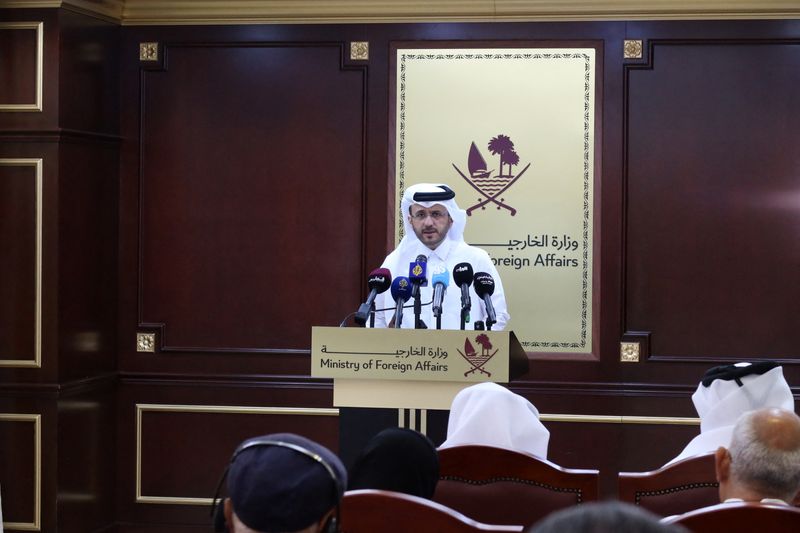By Andrew Mills and Ahmed Mohamed Hassan
DOHA/CAIRO (Reuters) – Sunday’s delayed start of the Gaza ceasefire and Monday’s incidents in which Israeli troops fired on Palestinians who approached them highlight some of the likely failures collide with an agreement that will take place in the shadow of mutual distrust and bitterness.
Qatar and Egypt, which negotiated the deal alongside the United States, have set up a communications center to resolve any issues, where officials who have worked on the deal for months hope to avoid further clashes between enemies locked in a cycle of several years of wars in Gaza. .
“These kinds of agreements are never easy to maintain,” said Majed Al-Ansari, a spokesperson for Qatar’s foreign ministry.
Particularly in a war zone, the situation can change very quickly, either by accident or because of political posturing on one side or the other, he explained.
“Any side could view a threat as a reason to violate the parameters of the agreement, and so we would end up having to intervene and find a way to resume the ceasefire.”
With just over an hour before the ceasefire took effect on Sunday, Prime Minister Benjamin Netanyahu announced that Israel would not observe a cessation of fighting until Hamas surrendered the names of the three hostages who will be released later today.
Fighting continued nearly three hours after the deadline, while a Hamas official in the Cairo-based coordination room discussed the delay, which Hamas blamed on unspecified “technical problems” with officials. .
The matter was eventually resolved and the three hostages were released as planned in the afternoon in exchange for 90 Palestinian prisoners released from Israeli jails late at night, sparking emotional scenes as they returned to their families .
“We don’t expect things to go as planned,” said an official briefed on the negotiations, adding that problems like this should not derail a process that diplomats and officials have been working on for months.
“It is hard to believe that after all the work the mediators have done and the assurances they have received, both from the United States and from the mediators, that this agreement would be derailed on day one,” said the responsible.
The phased deal provides for an initial six-week ceasefire, during which 33 hostages will gradually be exchanged for hundreds of Palestinian prisoners, displaced people from northern Gaza will be allowed to return home and Israeli troops will will withdraw from certain positions. .
During the first phase, negotiations will begin for the release of the remaining 64 hostages, consisting of men of military age, and for the complete withdrawal of Israeli troops. But few expect the process to go smoothly.
FUTURE OBSTACLES
With extremely low levels of trust between the two sides that have been fighting for generations, potential pitfalls range from accidental or deliberate clashes during the withdrawal period to disputes over the identity and condition of the hostages to be released or returned.
So far, Hamas has not said how many hostages are still alive. A list of the remaining 30 hostages to be released in the first phase, detailing whether they are alive or dead, is expected to be delivered on Saturday.
The Israeli military says it seeks to avoid situations in which Gazans get too close to withdrawing Israeli troops. Already on Monday, troops shot at least eight Palestinians who approached them, doctors in Gaza said.
To avoid this, it will issue maps and guidelines as the deal progresses, making clear which areas should not be approached as the withdrawal progresses, an Israeli military official said.
“The areas will change as troops gradually withdraw from the Gaza Strip,” the military official said.
In Israel, the deal is viewed with deep distrust by some, who say it leaves Hamas in control of Gaza, and others fear it will effectively abandon hostages not included in the first phase.
Already, hardliner Itamar Ben-Gvir resigned as national security minister the morning of the ceasefire and withdrew his party from Netanyahu’s coalition, and others could follow.
Israeli public radio reported that Israeli officials were shocked to see the three hostages freed Sunday in central Gaza get out of a car amid a large crowd held back by uniformed Hamas fighters, and they will inform the mediators that they consider such scenes unacceptable.
But mediators are counting on positive momentum as the releases of hostages and prisoners continue in the coming weeks to appease the opposition.

“The photos we saw yesterday of the three Israeli hostages meeting their families, being hugged by their families. These are the photos that could change public opinion on Israeli politics,” Ansari said. “The same goes for the Palestinian population, when they see 90 of their women and children returning to their families.”
“These are the kind of images that change public opinion. They put real pressure on leaders to maintain the deal.”

